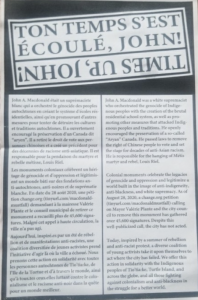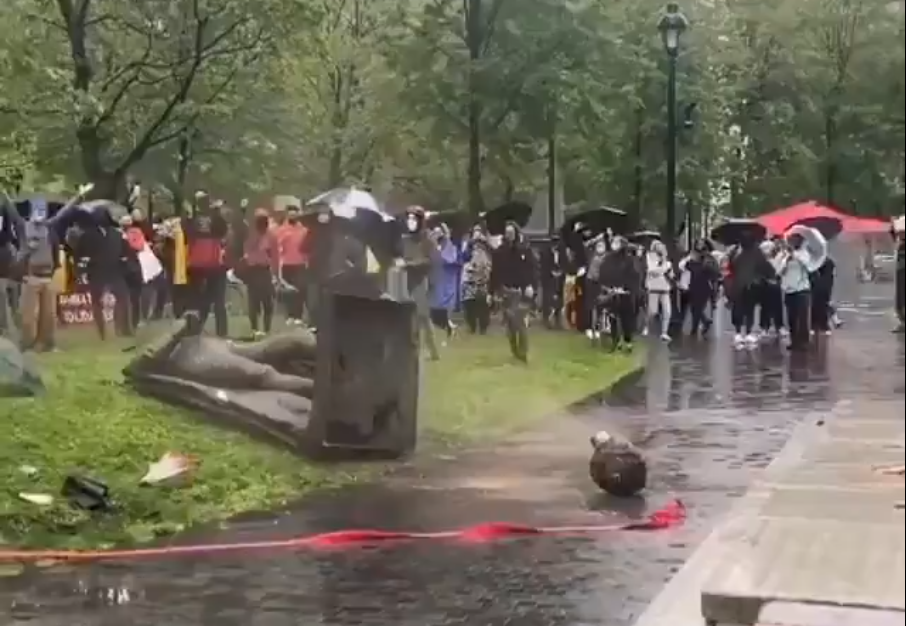The incident exposes Canada’s divided opinion over the the legacy of the former prime minister
A peaceful Montreal protest in favour of defunding the police ended abruptly on Saturday after a 125-year-old statue of Sir John A. Macdonald was toppled by an anonymous group of activists and protesters.
Politicians such as new Conservative leader Erin O’Toole and Mayor Valérie Plante have largely condemned the act, with Prime Minister Justin Trudeau saying Monday, “those kinds of acts of vandalism are not advancing the path towards greater justice and equality in this country.”
The protest was organized by the BIPOC Coalition for Liberation. In an interview with The Concordian, Elijah Olise, one of the coalition’s founders, said, “what we wanted from the protest is not what we got, because [we] got a lot of attention on the statue, and that’s not what we went out there for.”
“We were caught by surprise just as much as everybody else. Do I condone their actions? No…but also I do not condemn [them],” said Olise.
Statue taken down today in so-called #Montreal #BlackLivesMatter #DefundPolice #manifencours #decolonize Kanada pic.twitter.com/0TYGayWUiK
— Nore (@noreornot) August 29, 2020
The protest was coming to a close on Saturday afternoon, during which approximately 60 protesters remained at Place du Canada park. According to Olise, another organizer had set up a speaker system located roughly 250 metres away from the Sir John A. Macdonald statue for the closing ceremony speeches.
Olise introduced the speaker list and remained in front of the crowd of protestors watching the final speeches.
Meanwhile, several people had climbed up the monument base to stand next to the statue and install banners, a regular occurrence at various protests over the years.
Olise said he was focused on the crowd when a rope was thrown to the ground by people standing next to the statue. A few individuals grabbed the rope and started pulling, with some protestors joining in to help.
At around 2:45 p.m., the statue of Sir John A Macdonald came crashing down on the hard pavement, with its head flying off while protestors cheered.
“The statue came down in a very short amount of time,” said Olise.
SPVM spokesperson Jean-Pierre Brabant said that after the statue fell, the SPVM announced over a P.A. system for everyone to leave the area “for safety purposes and to establish a perimeter.”
“I realized at that point I was probably a target as an organizer,” said Olise. He said the police shot rubber bullets at him and other organizers and protesters as they collected equipment and left the area.
Brabant said, “there was no confrontation and no physical intervention.”
On their Facebook page, the BIPOC Coalition for Liberation wrote, “these racist monuments don’t deserve space.”
The organization added a list of demands for the police-defunding movement, such as reparations for the BIPOC community and RCMP off of Indigenous lands. They later added the “removal of all statues, plaques and emblems both on public and private property of any person, act, symbol, or movement that promotes or has promoted slavery, anti-Black racism, or anti-Indigenous racism.”
A flyer with the headline “TIME’S UP, JOHN” was distributed following the toppling of the statue, stating it was a deliberate act by an anonymous group of activists.
“We offer this action in solidarity with the Indigenous peoples of Tio’tia:ke, Turtle Island and across the globe,” the flyer continues, “and all those fighting against colonist and anti-blackness in the struggle for a better world,”
Olise obtained a copy and shared the contents with The Concordian.

Serge Simon, Grand Chief of the Mohawk council in Kanesatake told The Concordian he was “torn” regarding whether the statue should be permanently removed, or should stay as a “reminder.”
He explained how the former prime minister’s actions against Canada’s Indigenous Nation still resonate today, stating “everything Macdonald did laid the groundwork for later on, for the RCMP interventions against First Nations to the residential schools … Macdonald planted the seeds of First Nation suffering.”
“The lessons of history just can’t simply be wiped out by taking down the statue. Maybe the statue could remain, as a reminder of what not to do,” Simon added.
Nakuset, the executive director of the Native Women’s Shelter of Montreal, expressed concern over how the statue was removed, “if anyone should bring it down it should be the politicians, it shouldn’t be protestors.”
Nakuset said politicians should look into Macdonald’s history and compare it to the reconciliation promises that have been made.
“Don’t put up a statue without actually putting reconciliation forward,” said Nakuset.
Nakuset added that the statue could be replaced by Mary Two-Axe Earley, a human rights activist who helped change laws that discriminated against Indigenous women.
According to tweets by Valérie Plante, the city plans to reinstall the statue with new historical information on the former Prime Minister.
“Some historical monuments, here as elsewhere, are at the heart of current emotional debates. I reiterate that it’s better to put them in context rather than remove them. I am also in favour of adding monuments that are more representative of the society to which we aspire,” Plante said.
On Tuesday morning, Trudeau tweeted regarding a National historic designation for residential schools, saying, “We must acknowledge the dark and shameful chapters of our past, including the residential school system that tore Indigenous families and communities apart and has had enduring impacts on Indigenous peoples across the country. We must make sure such acts are never forgotten.”
The last residential school closed in 1996.
The SPVM has confirmed the statue has been taken by the City of Montreal for repair.
The SPVM is investigating the incident, and is working to identify a potential suspect involved.
Photo courtesy of @noreornot on Twitter




